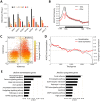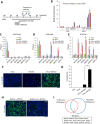Transient ectopic expression of the histone demethylase JMJD3 accelerates the differentiation of human pluripotent stem cells
- PMID: 27802135
- PMCID: PMC5087640
- DOI: 10.1242/dev.139360
Transient ectopic expression of the histone demethylase JMJD3 accelerates the differentiation of human pluripotent stem cells
Abstract
Harnessing epigenetic regulation is crucial for the efficient and proper differentiation of pluripotent stem cells (PSCs) into desired cell types. Histone H3 lysine 27 trimethylation (H3K27me3) functions as a barrier against cell differentiation through the suppression of developmental gene expression in PSCs. Here, we have generated human PSC (hPSC) lines in which genome-wide reduction of H3K27me3 can be induced by ectopic expression of the catalytic domain of the histone demethylase JMJD3 (called JMJD3c). We found that transient, forced demethylation of H3K27me3 alone triggers the upregulation of mesoendodermal genes, even when the culture conditions for the hPSCs are not changed. Furthermore, transient and forced expression of JMJD3c followed by the forced expression of lineage-defining transcription factors enabled the hPSCs to activate tissue-specific genes directly. We have also shown that the introduction of JMJD3c facilitates the differentiation of hPSCs into functional hepatic cells and skeletal muscle cells. These results suggest the utility of the direct manipulation of epigenomes for generating desired cell types from hPSCs for cell transplantation therapy and platforms for drug screenings.
Keywords: Hepatocytes; Histone demethylase; Human pluripotent stem cells; JMJD3; KDM6B; Skeletal muscle.
© 2016. Published by The Company of Biologists Ltd.
Conflict of interest statement
The authors declare no competing or financial interests.
Figures






Similar articles
-
JMJD3: a critical epigenetic regulator in stem cell fate.Cell Commun Signal. 2021 Jul 3;19(1):72. doi: 10.1186/s12964-021-00753-8. Cell Commun Signal. 2021. PMID: 34217316 Free PMC article. Review.
-
EZH2, JMJD3, and UTX epigenetically regulate hepatic plasticity inducing retro-differentiation and proliferation of liver cells.Cell Death Dis. 2019 Jul 8;10(7):518. doi: 10.1038/s41419-019-1755-2. Cell Death Dis. 2019. PMID: 31285428 Free PMC article.
-
Vitamin C-dependent lysine demethylase 6 (KDM6)-mediated demethylation promotes a chromatin state that supports the endothelial-to-hematopoietic transition.J Biol Chem. 2019 Sep 13;294(37):13657-13670. doi: 10.1074/jbc.RA119.009757. Epub 2019 Jul 24. J Biol Chem. 2019. PMID: 31341023 Free PMC article.
-
p53 interaction with JMJD3 results in its nuclear distribution during mouse neural stem cell differentiation.PLoS One. 2011 Mar 31;6(3):e18421. doi: 10.1371/journal.pone.0018421. PLoS One. 2011. PMID: 21483786 Free PMC article.
-
Pleiotropic Functions of H3K27Me3 Demethylases in Immune Cell Differentiation.Trends Immunol. 2016 Feb;37(2):102-113. doi: 10.1016/j.it.2015.12.004. Epub 2016 Jan 19. Trends Immunol. 2016. PMID: 26796037 Free PMC article. Review.
Cited by
-
The role of α-ketoglutarate-dependent proteins in pluripotency acquisition and maintenance.J Biol Chem. 2019 Apr 5;294(14):5408-5419. doi: 10.1074/jbc.TM118.000831. Epub 2018 Sep 4. J Biol Chem. 2019. PMID: 30181211 Free PMC article. Review.
-
JMJD3: a critical epigenetic regulator in stem cell fate.Cell Commun Signal. 2021 Jul 3;19(1):72. doi: 10.1186/s12964-021-00753-8. Cell Commun Signal. 2021. PMID: 34217316 Free PMC article. Review.
-
Synthetic mRNA-based differentiation method enables early detection of Parkinson's phenotypes in neurons derived from Gaucher disease-induced pluripotent stem cells.Stem Cells Transl Med. 2021 Apr;10(4):572-581. doi: 10.1002/sctm.20-0302. Epub 2020 Dec 20. Stem Cells Transl Med. 2021. PMID: 33342090 Free PMC article.
-
Engineered skeletal muscles for disease modeling and drug discovery.Biomaterials. 2019 Nov;221:119416. doi: 10.1016/j.biomaterials.2019.119416. Epub 2019 Aug 8. Biomaterials. 2019. PMID: 31419653 Free PMC article. Review.
-
EZH2, JMJD3, and UTX epigenetically regulate hepatic plasticity inducing retro-differentiation and proliferation of liver cells.Cell Death Dis. 2019 Jul 8;10(7):518. doi: 10.1038/s41419-019-1755-2. Cell Death Dis. 2019. PMID: 31285428 Free PMC article.
References
-
- Akiyama T., Xin L., Oda M., Sharov A. A., Amano M., Piao Y., Cadet J. S., Dudekula D. B., Qian Y., Wang W. et al. (2015). Transient bursts of Zscan4 expression are accompanied by the rapid derepression of heterochromatin in mouse embryonic stem cells. DNA Res. 22, 307-318. 10.1093/dnares/dsv013 - DOI - PMC - PubMed
-
- Akutsu H., Machida M., Kanzaki S., Sugawara T., Ohkura T., Nakamura N., Yamazaki-Inoue M., Miura T., Vemuri M., Rao M. S. et al. (2015). Xenogeneic-free defined conditions for derivation and expansion of human embryonic stem cells with mesenchymal stem cells. Regen. Ther. 1, 18-29. 10.1016/j.reth.2014.12.004 - DOI - PMC - PubMed
Publication types
MeSH terms
Substances
LinkOut - more resources
Full Text Sources
Other Literature Sources
Molecular Biology Databases
Research Materials

